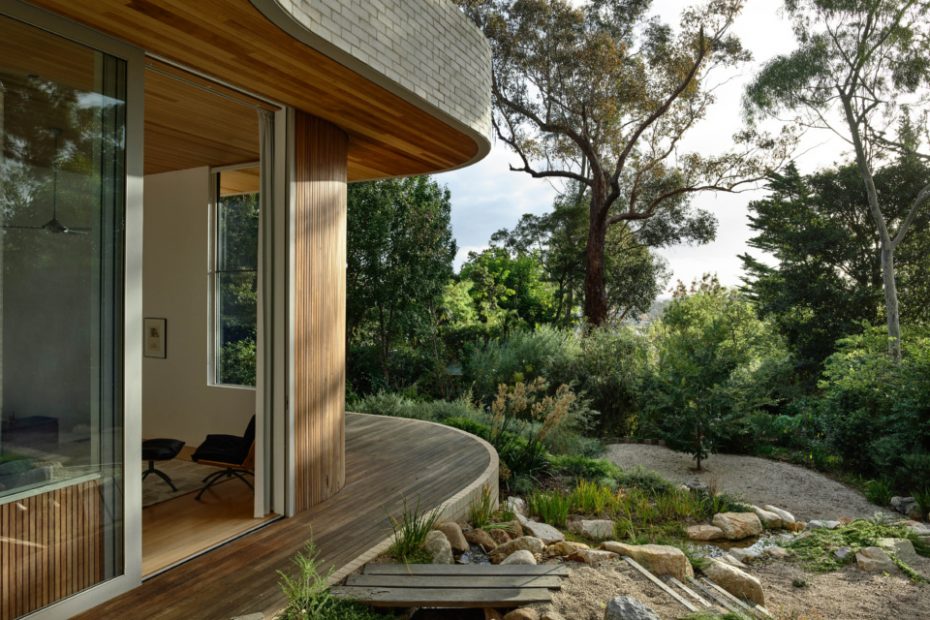A Renovated 1930s Home That Draws Its Garden In
Architecture
Garden House by Zen Architects is a renovated and extended 1930s home.
The house is located in the Mount Eagle Estate is a unique area within the suburb of Melbourne suburb of Eaglemont where houses are secondary, and vegetation is protected.
Zen Architects took the approach of reducing the size of the home, returning the garden to be the main focus in keeping with the original design of the area.
‘It is about the house wrapping around the garden and bringing the garden deep into the heart of the house,’ says Luke Rhodes, director of Zen Architects, who designed the renovation.
A created void drawn deep into the plan becomes a space for outdoor living.
Where previously one had to pass through three rooms to gain any appreciation of the garden, this is now evident from the moment you open the front door.
Northern light streams into the kitchen window.
Thick stone floors line the main living spaces providing thermal mass to help moderate temperature fluctuations.
The communal spaces (kitchen, dining, family and lounge) span the rear of the home.
One of two bathrooms in the home.
The home features two bedrooms and an office.
The Mount Eagle Estate is a unique area within the suburb of Eaglemont, located about 10 kilometres north-east of Melbourne’s CBD.
Designed by Walter Burley and Marion Mahony Griffin in 1914, the estate comprises an innovative and experimental design adopting principles from the ‘garden city movement.’ Here, houses are secondary, and vegetation is protected by heritage and significant landscape overlays.
‘Entering the estate, you are immediately aware of the significance of this place and that is due to the dominance of the landscape — from heavily planted nature strips to the dense and towering treetops that wrap around the meandering roads,’ says Luke Rhodes, director of Zen Architects, who designed the renovation.
None of these attributes were captured in this previously-renovated 1930s house, owned by the one family for two decades.
‘The floor plan was deep and wide, lacking connection and light. We identified wasted space through the middle of the house as furniture was pushed to the perimeters in a bid to try and connect with the landscaped setting,’ Luke says.
The brief called for updated amenities, improved comfort, and an enhanced connection to the garden — not additional accommodation. As such, Zen Architects took the approach of reducing the size of the home, ensuring the garden would remain as the central feature of the property.
‘The teardrop gardens created by the contoured road plan of the estate informed the architectural intervention,’ says Luke. ‘It is about the house wrapping around the garden and bringing the garden deep into the heart of the house.’
Where previously one had to pass through three rooms to gain any appreciation of the garden, this is now evident from the moment you open the front door. The communal spaces (kitchen, dining, family and lounge) span the rear of the home, receiving prime views of the garden designed by Ben Harris Gardens, through a rear wall of curving glass.
The building materials used are reflective of original homes in the estate, and the natural environment. The masonry (brick) rear façade is gently carved out, revealing a protected timber ‘skin’ of vertically laid cladding, and horizontally laid decking, flooring, and ceiling. A created void drawn deep into the floorplan becomes a space for outdoor living.
In renovating the home, Zen Architects also improved the home’s energy efficiency, and replaced existing appliances to all-electric alternatives.
‘Despite a third of the total footprint of the house being the original 1930s [structure], and retaining the original uninsulated double brick walls and single glazed windows, we managed to bring the entire house up to a 6 star energy rating,’ Luke says.
The home is now not only incredibly beautiful, but much more functional and liveable, with its improved floorplan and strong connection to nature.
Luke says, ‘I am incredibly proud of the profound impact this project has had on the way you experience the site, with the minimum of impact.’
